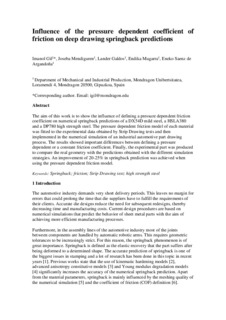Izenburua
Influence of the pressure dependent coefficient of friction on deep drawing springback predictionsEgilea
Bertsioa
Postprinta
Eskubideak
&2016 Elsevier Ltd. All rights reservedSarbidea
Sarbide irekiaArgitaratzailearen bertsioa
http://dx.doi.org/10.1016/j.triboint.2016.07.004Non argitaratua
Tribology International Vol. 103. Pp. 266–273. November, 2016Lehenengo orria
266Azken orria
273Argitaratzailea
Elsevier Ltd.Gako-hitzak
springbackFriction
strip drawing test
High strength steel
Laburpena
The aim of this work is to show the influence of defining a pressure dependent friction coefficient onnumerical springback predictions of a DX54D mild steel, a HSLA380 and a DP780 high strength steel. ... [+]
The aim of this work is to show the influence of defining a pressure dependent friction coefficient onnumerical springback predictions of a DX54D mild steel, a HSLA380 and a DP780 high strength steel. Thepressure dependent friction model of each material wasfitted to the experimental data obtained by StripDrawing tests and then implemented in the numerical simulation of an industrial automotive partdrawing process. The results showed important differences between defining a pressure dependent or aconstant friction coefficient. Finally, the experimental part was produced to compare the real geometrywith the predictions obtained with the different simulation strategies. An improvement of 20–25% inspringback prediction was achieved when using the pressure dependent friction model. [-]





















